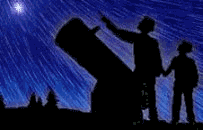

 |
 |
A Guide to when to look for beginning Amature Astronomers |
1- First thing to check is to make sure that your
telescopes tempature is equal to the outside by letting it sit for awhile.
2- The next
thing to check for, is that you are not looking over someones roof or worse their
chimney. The heat waves from inside your telescope, roof, or chimney causes everything
to wiggle and swim around just like the heat waves along the ground on a hot summers day
does.
The answer to these problems is simple let your telescope settle for about 30 min.
and move your telescope so you don't have look over a heat source.
3- The last reason
for not seeing clear is a unsettled atmosphere.
Your main clue for not seeing very good that night is
the sparkling stars. The more a star sparkles the more unsettled the air is and the worse your viewing
will be. This is caused by the same culprit as before heat. This time it is in the atmosphere an there is
little you can do about it. The problem may improve as the night wears on because
the ground cools and the air does not get heated and rise. So you can try waiting it out,
but most likely you will have to pick another night or settle for low power viewing.
